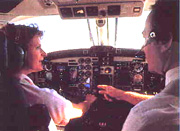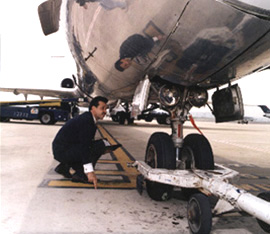Photo Album - The FAA Today
- Headquarters and Field Organization
- Air Traffic Services
- Research and Acquisitions
- Regulation and Certification
- Airports
- Commercial Space Transportation
Regulation and Certification
In the pursuit of safety, the FAA issues rules and sets standards for both aeronautical equipment and people working in the aviation field.
 Aircraft certification begins in the manufacturing plant, where FAA experts work with company engineers to ensure high standards of airworthiness. If all goes well, new models receive a type certificate, followed by a certificate authorizing production. Individual planes must also be certificated to ensure their conformity to standards, and the FAA applies the same scrutiny to engines and other components. If problems appear during the service life of an aircraft, the agency issues airworthiness directives requiring corrective action.
Aircraft certification begins in the manufacturing plant, where FAA experts work with company engineers to ensure high standards of airworthiness. If all goes well, new models receive a type certificate, followed by a certificate authorizing production. Individual planes must also be certificated to ensure their conformity to standards, and the FAA applies the same scrutiny to engines and other components. If problems appear during the service life of an aircraft, the agency issues airworthiness directives requiring corrective action.
|

|
Any person involved in operating or maintaining an aircraft must hold an FAA certificate. Pilots must demonstrate the knowledge, skills, and experience prescribed for the type of certificate and rating desired. Similar certification is required for such groups as mechanics, dispatchers, and instructors. |
| Airlines, too, must have an operating certificate. FAA teams evaluate training, performance, and maintenance to check their continuing compliance. Repair stations, flight schools, and air carrier airports are also covered by certification requirements. These programs carry FAA people into every corner of the aviation world, where they act in cooperation with industry to guarantee high safety standards. |

|
